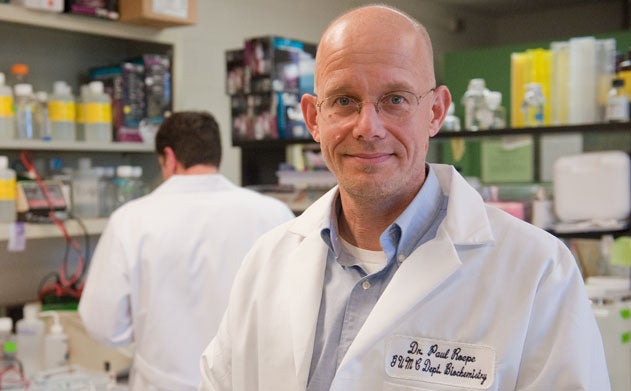Title: NIH $4.75 Million Grant Received for New Approach to Drug-Resistant Malaria
Paul Roepe, a Georgetown College chemistry professor, will lead a study to identify drug combinations that work effectively against strains of drug-resistant malaria.

A Georgetown College chemistry professor is principal investigator for a new $4.75 million, five-year National Institutes of Health (NIH) grant to identify combinations of two or more drugs that will work effectively against current strains of drug-resistant malaria.
A mosquito-borne disease caused by a parasite, malaria killed more than 650,000 people in 2010 – most of them children in Africa, according to the World Health Organization. And while several antimalarial drugs have successfully treated the disease, in some regions they no longer work due to drug resistance.
“There is an immediate and dire need to rapidly identify and prioritize antimalarial drug combinations for clinical use,” says Paul Roepe, also a professor of biochemistry and cellular and molecular biology and co-founder of Georgetown’s Center for Infectious Disease at Georgetown University Medical Center (GUMC). “Combination therapy has the best chance of reducing the frequency at which new drug resistance phenomena emerge, and our preliminary data suggest that dozens of previously unrecognized drug combinations with high degrees of synergy can be rapidly identified by our new approach.”
A Five-Laboratory Effort
Roepe is heading the effort that will be carried out by his research team at Georgetown with two labs at Johns Hopkins University and another two at NIH.
One of the labs – at NIH’s National Center for Advancing Translational Services (NCATS) – already has developed robots for testing drug combinations.
Roepe says Craig Thomas at NCATS, now also an adjunct at GUMC, is leading that part of the overall project, and the two will co-mentor graduate students working on the project.
“Craig and his colleagues have developed a robotics platform for rapidly screening high numbers of drug combinations,” Roepe explains. “My lab will attempt to figure out which of the drug combinations from the initial screens really are the best by using a number of other measures.”
Previous Research
Roepe has a long history of working on drug-resistant malaria at Georgetown.
This past November, he published the first study explaining a new pathway for how drugs designed to fight off malaria stop working in some people with the disease in the online journal PLOS ONE.
That study, authored with colleagues at the University of Notre Dame and the University of Kentucky, found genetic and cell biological evidence linking autophagy to drug resistance in the parasite, which kills the effects of some drugs. Autophagy is the process by which cells remove damaged parts of themselves to restore normal function.
Drug Synergy
The goal of the new NIH-funded study is “to find not just another active antimalarial drug, but synergistic antimalarial drug combinations,” Roepe says. “We are looking for two or more drugs that together have a more than additive effect relative to the drugs alone.”
Drug synergy, Roepe adds, is not a new concept, but has never before been systematically studied for malaria. This is mostly because it is far more difficult to rapidly measure drug sensitivities for malarial parasites, compared to bacteria or tumor cells. Now that his lab has conquered that problem, he says it is ready for a project of the new study’s magnitude.
“Most experts around the globe agree that due to rampant antimalarial drug resistance we cannot use individual antimalarial drugs alone, we must use combinations of two or more,” Roepe says. “Using combination therapy lowers the chance for the emergence of additional drug resistance phenomena, and is likely to slow the spread of existing drug resistant strains. I am hopeful that this large-scale project will cast a very wide net toward identifying dozens of potential antimalarial drug combinations with which we can better control malaria on a global scale.”